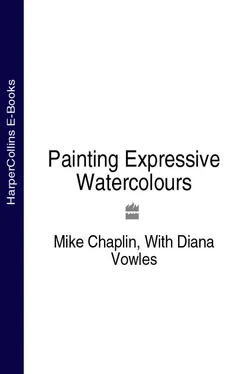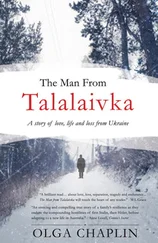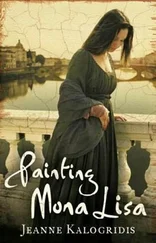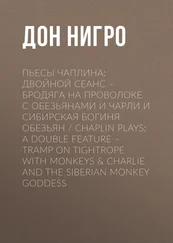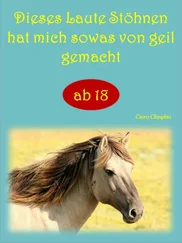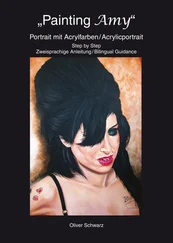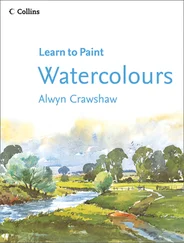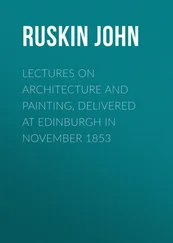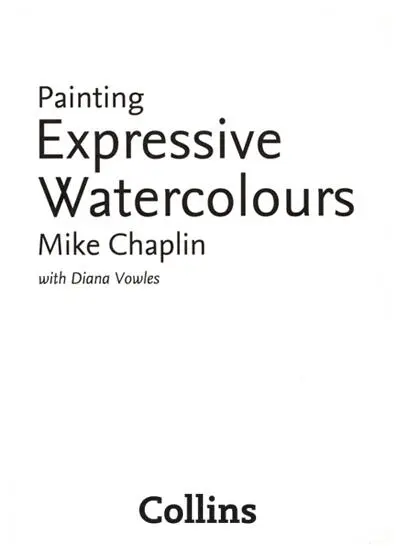
Cover
Title Page
Introduction Introduction Watercolour is a medium that is capable of expression ranging from the most finely detailed of botanical studies to the most loosely gestural of marks. As a pigment it is easy to take out into the countryside and as a painting it is comfortable in a domestic environment and very portable for travelling exhibits. Such accessibility has gained it a unique standing with both professional and amateur artists. ITALIAN ALPS 45.5 × 66cm (18 × 26in) This picture was painted in the studio from a small study I did on a coach on the way through Italy. I awoke at 6 am, with cold England several hours behind me, and drew a five-minute sketch to catch the memory of the warmth of the stones and the mountainous landscape.
Materials and Equipment
Focus on: grinding paint
Techniques
Focus on: working with mixed media
Demonstration: The sunken pond
Finding Your Inspiration
Focus on: using a camera for reference
Drawing
Focus on: bringing it all together
Tone and Colour
Focus on: using black and white
Demonstration: A quiet interior scene
Composition
Focus on: the Golden Section
The Natural Landscape
Demonstration: The harbour
The Urban Landscape
Demonstration: The street market
Copyright
About the Publisher
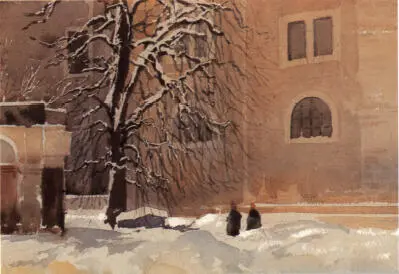
Introduction Introduction Introduction Watercolour is a medium that is capable of expression ranging from the most finely detailed of botanical studies to the most loosely gestural of marks. As a pigment it is easy to take out into the countryside and as a painting it is comfortable in a domestic environment and very portable for travelling exhibits. Such accessibility has gained it a unique standing with both professional and amateur artists. ITALIAN ALPS 45.5 × 66cm (18 × 26in) This picture was painted in the studio from a small study I did on a coach on the way through Italy. I awoke at 6 am, with cold England several hours behind me, and drew a five-minute sketch to catch the memory of the warmth of the stones and the mountainous landscape. Materials and Equipment Focus on: grinding paint Techniques Focus on: working with mixed media Demonstration: The sunken pond Finding Your Inspiration Focus on: using a camera for reference Drawing Focus on: bringing it all together Tone and Colour Focus on: using black and white Demonstration: A quiet interior scene Composition Focus on: the Golden Section The Natural Landscape Demonstration: The harbour The Urban Landscape Demonstration: The street market Copyright About the Publisher
Watercolour is a medium that is capable of expression ranging from the most finely detailed of botanical studies to the most loosely gestural of marks. As a pigment it is easy to take out into the countryside and as a painting it is comfortable in a domestic environment and very portable for travelling exhibits. Such accessibility has gained it a unique standing with both professional and amateur artists.
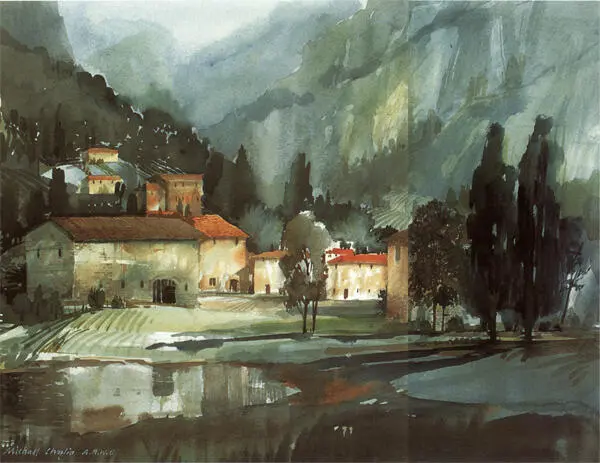
ITALIAN ALPS
45.5 × 66cm (18 × 26in)
This picture was painted in the studio from a small study I did on a coach on the way through Italy. I awoke at 6 am, with cold England several hours behind me, and drew a five-minute sketch to catch the memory of the warmth of the stones and the mountainous landscape.
In its simplest form, watercolour was used in Europe more than 10,000 years ago when cave-dwellers of the Upper Palaeolithic era mixed red earth with water and used it to paint pictures of hunters and their prey on the cave walls. Yet in the Christian era in Britain, it was not appreciated as an art medium in its own right until the 19th century, when Queen Victoria gave the royal seal of approval that brought it firmly into the purview of the art establishment.
It may have been watercolour’s simplicity that made it seem inferior to the business of sculpting and painting in oils. A provincial artist of the 15th century would have had to make do with what could be obtained in his village, and a simple starch glue combined with pigment was easier to achieve than the more complex binder and oils required for oil painting. Pigment itself was scarce, and the artist would often accept it as his fee.
By the 18th century, watercolour was well established as a means of making a topographical view of the landscape. While families making the Grand Tour of Europe took along their art tutor, in effect to provide the holiday photographs, professional artists such as Alexander Cozens (1717–1786) and Francis Towne (1740–1816) travelled extensively in Italy. It became part of the English tradition that one went abroad to do watercolour paintings of exotic ruins – except that they were known as watercolour drawings, as the medium was not even dignified by the recognition that it was paint.
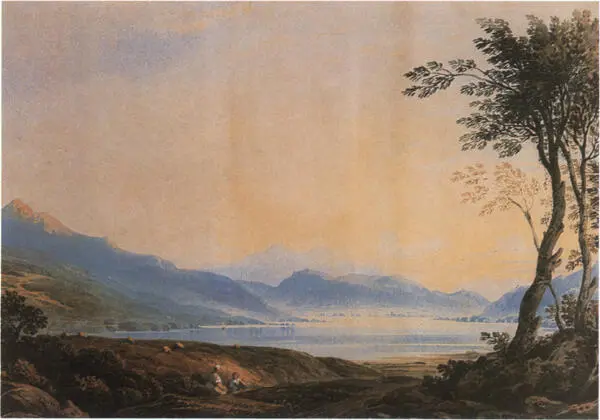
CADER IDRIS, NORTH WALES
John Varley (1778–1842)
24 × 35cm (9 1/ 2× 13 3/ 4in)
In this classic landscape the tree acts as a framing device and points the eye towards the figures almost hidden below the bank. Their comparative insignificance was a new development in art.
In 1799 the Napoleonic Wars broke out and Europe was closed to the British traveller. Artists were forced to turn to their native landscape, and the land itself became a subject rather than being a backdrop for portraiture. John Varley (1778–1842), Thomas Girtin (1775–1802), John Sell Cotman (1782–1842) and David Cox (1783–1859) ushered in the golden age of British watercolour, while. Richard Parkes Bonington (1802–1828), William Callow (1812–1908) and, above all, Joseph Mallord William Turner (1775–1851) drew inspiration from the maritime tradition of the nation. Girtin and Turner in particular explored the capacity of watercolour for creating atmospheric effects, experimenting with texture and colour.
The art establishment continued to reject watercolour nevertheless, and in 1804 a group of watercolourists instigated an annual exhibition in London. No fewer than 11,000 people attended in the first year, and by 1809 visitor numbers had risen to 23,000. These paintings of landscapes that were still largely inaccessible to town-dwellers aroused enormous interest, and in 1881 the Society of Painters in Watercolour was granted a royal charter and subsequently became known as the Royal Watercolour Society. By this time Europe was available again to travellers such as Francis Oliver Finch (1802–1862) and Edward Lear (1812–1888), but the British had now taken watercolours of their own land to their hearts.
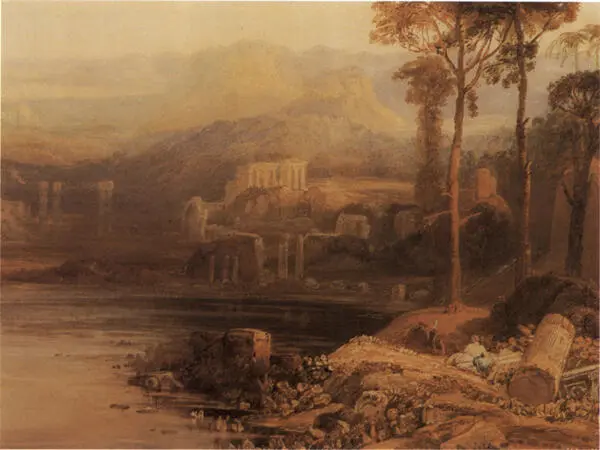
CLASSICAL LANDSCAPE
Читать дальше
